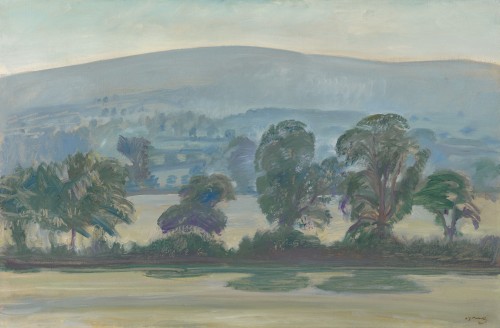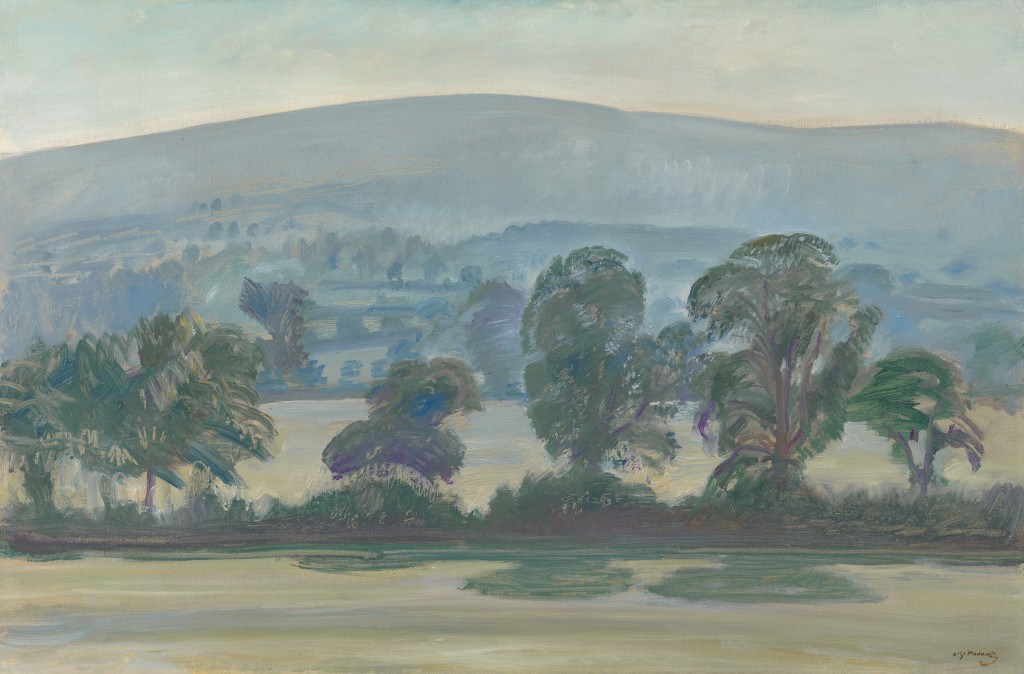SIR ALFRED MUNNINGS
Mendham 1878 - 1959 Dedham
Ref: BS 224
Dunkery Beacon from Selworthy, Exmoor
Signed lower right: A.J. Munnings; inscribed on the stretcher: Dunkery from Selworthy
Oil on canvas: 20 x 30¼ in / 50.8 x 76.8 cm
Frame Size: 26¼ x 36¼ in / 66.7 x 92.1 cm
Painted in the 1940s
Provenance:
Private collection, UK
In the 1920s Alfred Munnings’s second wife, Violet, who was a superb equestrienne, bought a cottage, ‘Riverside’, at Withypool in Somerset. She hunted on Exmoor with the Devon and Somerset Staghounds, enjoying more challenging terrain than the hunting in East Anglia. In 1940 Munnings’s home, Castle House at Dedham in Essex was requisitioned by the Army and he moved to Withypool, finding a curious freedom in the midst of conflict by painting pure landscape, unburdened by irksome commissions. Munnings wrote lyrically of Exmoor: ‘In the spring white blackthorn blossom, and later the hawthorn. With glistening stalks of dead bracken around, and young green fronds uncurling through ... bluebells a faint mist on the slope, and songs of blackbird and thrush in the air, I have sat in the shadow of an aged thorn in blossom, painting massed white blossoming trees below, casting their shadows on the hillside and their scent all around. Farther below still, the gleam of a small stream rippling over stones in the sun, its sweet, silvery music ascending, mingling with the blackbird’s song’[1].
This work depicts a favourite motif which Munnings painted frequently before and during the Second World War, the view from Selworthy (on the northern side of Exmoor, about eight miles from Withypool) to Dunkery Beacon. The Beacon stands on Dunkery Hill, at 1700 feet the highest point on Exmoor. The open-ended composition gives a sense of the panoramic, unfettered landscape. So different from East Anglia, with its gentle hills, fields of wheat and flower-strewn water meadows, Munnings found a new source of inspiration that perhaps took him back to the wild countryside of his Cornish sojourn, before the First World War. He painted Dunkery in every time of day and type of weather, pitting his vision and technique against changeable Nature in the way that Monet caught every mood of his gardens at Giverny. A number of these Dunkery paintings can be seen at the Munnings Art Museum at Castle House.
In Dunkery Beacon from Selworthy, the rich agricultural terrain of the foreground, with a line of elms and other trees casting coloured shadows, gives way to the hazy, bare moorland, which rises to meet a horizon that glows with a faint line of apricot beneath a cloud-flecked blue sky. The painting is a poetic assemblage of gentle tonalities, with cool blues and greens predominating. The vigour and immediacy of Munnings’s technique is apparent in the rapidly-brushed shapes of the foreground trees and the textures added with a dragged, half-dry brush and highlights scratched with the wooden end of the brush. Munnings’s deep and delicate response to the natural world is fully apparent.
SIR ALFRED MUNNINGS, PRA, RWS
Mendham 1878 - 1959 Dedham
Born in Mendham, Suffolk, Alfred Munnings was the son of a miller. He was apprenticed to a firm of lithographers from 1893 to 1898 and studied at the Norwich School of Art and in Paris. There he was impressed with plein-air naturalism; this, together with his introduction to the racecourse in 1899, influenced the themes for which he became famous.
While in Mendham, Munnings painted many scenes of country life, particularly horse fairs. He went to Cornwall in 1908, and for many years was an important addition to the Newlyn School of artists. When the First World War broke out, Munnings enlisted, despite having the use of only one eye owing to an accident in 1899. He became an army horse trainer near Reading and later went to France as an official war artist, attached to the Canadian Cavalry Brigade.
The year 1919 was a major turning-point in all aspects of Munnings’s life; he painted his first racehorse, Pothlyn, the winner of the Grand National, and became an Associate of the Royal Academy. He met Violet McBride, whom he was to marry, and bought Castle House, Dedham, where the Munnings Memorial Trust maintains a permanent exhibition of his pictures. Munnings’s prolific career, spanning over 60 years, brought him honour, with election to the Presidency of the Royal Academy in 1944, a Knighthood in 1945, and a personal award from the Sovereign in 1947, when he was created Knight of the Royal Victorian Order.
[1] Sir Alfred Munnings, The Finish, London 1952, p. 105.



























